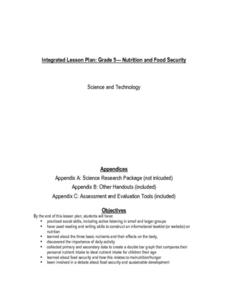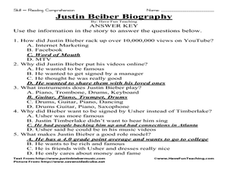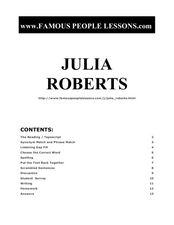Curated OER
"Nutcracker"
Students recognize the timbre of a celesta by listening to music that contains the celesta. They listen to music from Tchaikovsky's "Danse de la Fee-Dragee" (Dance of the Sugar-Plum Fairies), track #14 and describe how the music...
Curated OER
Who's Who at Our School?
Students recognize and use language appropriately for varied contexts and purposes. Students integrate listening, speaking, viewing, reading, and writing for multiple purposes. Students develop and use a variety of strategies to plan,...
Curated OER
The Seasons of the Year
Students learn about the four seasons. They collaborate in pairs, publish a book, and share with the class. They also brainstorm and collaborate with each other providing literacy skills through listening, speaking and writing activities.
Curated OER
Nutrition and Food Security
Examine the three basic nutrients and their effects on the body. Fifth graders will research data to construct a bar graph and then demonstrate the relationship between malnutrition and food security. This is a very comprehensive...
Curated OER
Chinese Zodiac
Fifth graders identify the basic elements of a narrative story, such as the beginning, middle, and the end; to analyze the character traits in the story to write a summary using the 5 Ws and How chart included; through sample stories...
Curated OER
Using "Why Mosquitoes Buzz in People's Ears" to Teach Cause and Effect
Students discuss cause and effect relationships and the chain reaction involved before listening to the story "Why Mosquitoes Buzz in People's Ears". Students create flow charts to show the chain reactions of causes and effects in the...
Curated OER
Consonant or Vowel
Learners discover what the teacher has revealed about them after leaving the room for a few minutes. A scenario is set up to which if the question ends with a vowel they answer "yes" or if it ends with a consonant they answer "no." After...
Curated OER
Homelessness
Students explore homelessness. In this speaking, listening, and critical thinking lesson plan, students listen to and discuss 3 scenarios in which families from urban, rural, and suburban communities became homeless due to different...
Curated OER
Justin Beiber Biography
In this Justin Beiber learning exercise, students read a biography on Justin Beiber and answer multiple choice questions about him. Students complete 5 questions.
Curated OER
Justin Bieber
In this famous person worksheet, students read a passage about Justin Bieber and then complete worksheets such as spelling, a listening gap fill, synonym matching, scrambled sentences, and more.
Curated OER
Lewis Hamilton
In this famous person worksheet, students read a passage about Lewis Hamilton and then complete worksheets such as spelling, a listening gap fill, synonym matching, scrambled sentences, and more.
Curated OER
Lionel Messi
In this famous person activity, learners read a passage about Lionel Messi and then complete worksheets such as spelling, a listening gap fill, synonym matching, scrambled sentences, and more.
Curated OER
Writing American Diaries
Young scholars examine the concept of historical perspective in writing. They read the diary of Sally Wister, a young Patriot from Philadelphia during the Revolutionary Era. Additionally, they must include different points of view in...
San Francisco Symphony
Learning Adjectives through the Duke
Duke Ellington, jazz, and jive kick-off a fun and creative lesson on responding emotionally to music. The class will learn about jive talk used in the 1920s and the life and music of Duke Ellington. They'll listen to a selection of his...
Curated OER
The Finer Things in Life
Momoyama and Edo are periods in Japanese history that can be defined culturally and artistically. Learners explore and discuss how the samurai used sword guards and grip enhancers. Pupils read the story "The Inch-High Samurai," examine...
Curated OER
Julia Roberts
In this famous person worksheet, students read a passage about Julia Roberts and then complete worksheets such as spelling, a listening gap fill, synonym matching, scrambled sentences, and more.
Curated OER
Kitano Takeshi
In this Kitano Takeshi worksheet, students read a passage about Kitano Takeshi and then complete worksheets such as spelling, a listening gap fill, synonym matching, scrambled sentences, and more.
Curated OER
Men of Steel
Students explore early 20th century steel making. In this U.S. history steel making activity, students view and describe a postcard and a picture depicting exaggerated aspects of the steel industry. Students listen to a poem about Joe...
Federal Reserve Bank
Cotton in My Sack
As part of a study of saving choices and opportunity costs, class members listen to a reading of Lois Lenski's Cotton in My Sack, and then evaluate the spending choices made by the Hutley family.
Curated OER
Build a Connection
Learners discuss their personal connections with stories they've read in the past and identify techniques to connect with more stories. They create illustrations, construct task cards, and complete sentence stems based on books they read...
Curated OER
The Learning Network: Alligators Everywhere Fill-In
Meant to be used with the article, "In Florida, the Natives Are Restless" (included here), this is a great source of high-interest, nonfiction reading. A fill in the blank vocabulary activity and an activity focusing on reading...
San Francisco Symphony
Admirable Armonica Admirers
What do Ben Franklin and Wolfgang Mozart have in common? Find out about the musical invention, the armonica or glassy-chord. Learners will read about how Ben Franklin invented this new instrument and how Wolfgang Mozart came to play it....
Art Institute of Chicago
African Myths and Stories
Young historians discover African stories associated with a royal altar tusk from the Kingdom of Benin in Nigeria, read myths illustrated on the tusk, and write a story about the life of an oba using figures depicted on the tusk.
PBS
Heart to Heart
Study heart health and math in one activity. After measuring their resting heart rates by finding the pulse in their wrists, learners build a stethoscope to listen to their heart rate, and note the differences between the two methods.

























